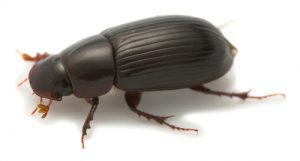Sawtoothed Grain Beetles are Tough Pantry Pests!
By Chris Williams on September 8, 2011.
Q. About six months ago, we had a problem with sawtoothed beetles in our kitchen. We eventually tracked them down to an old box of pancake mix. We got rid of that, washed down the kitchen shelves, and I thought we were done. But now they’re back. What should I do now?
A. Finding and completely eliminating a sawtoothed grain beetle infestation can be a daunting task. One reason the sawtoothed grain beetle is such a successful pest is because it feeds on almost any stored food – from cereals, flour, and pasta to dried fruit, nuts, and spices. It can be infesting almost anything in your kitchen.
In the food industry, this beetle is known as a secondary invader or scavenger in food products because a sawtoothed grain beetle infestation often follows infestation by some other primary food pest. It doesn’t have strong enough jaws to infest whole grains or beans, but if these foods have already been attacked by some other pest, or damaged in some way, sawtoothed grain beetles will feed on the broken kernels.
 The adult beetle is brown and very small (1/8 inch long or less). Because it’s tiny with a flattened body, this beetle can hide in cracks and crevices and can even get into sealed packages. If you have a magnifying glass or a microscope, you can see how the sawtoothed grain beetle gets its name. It has 6 saw-teeth on each side of its thorax, just behind the head. The adult can run rapidly but does not fly. Both the adult beetle and the tiny whitish larvae feed on the same food products.
The adult beetle is brown and very small (1/8 inch long or less). Because it’s tiny with a flattened body, this beetle can hide in cracks and crevices and can even get into sealed packages. If you have a magnifying glass or a microscope, you can see how the sawtoothed grain beetle gets its name. It has 6 saw-teeth on each side of its thorax, just behind the head. The adult can run rapidly but does not fly. Both the adult beetle and the tiny whitish larvae feed on the same food products.
Sawtoothed grain beetle populations can build up quickly. The female lays up to 285 eggs right in her food supply. The length of time for one life cycle (from egg to adult) can vary from as little as 20 days to more than one year, depending on temperature, humidity, and food quality. There were no doubt eggs left behind in your kitchen, either in cracks and crevices or in other food products, and those hatching eggs allowed the population to build back up again.
Like most other stored food pests, the sawtoothed grain beetle is most often found infesting foods that are old, overlooked, or damaged. In home pantries, this often means food that is on the back of the shelf and is past its “use by” date. Start your inspection with the oldest products first. You’ll need to pour out the contents of the box or bag onto a cookie sheet and use a spatula to spread out the product. Using a flashlight, you may see movement from the tiny larvae that are dirty white with small yellow plates on their back. When they’re ready to pupate, they cover themselves with pieces of the food product. You may also see shed larval skins or even the dark adult beetles.
To be thorough, you’ll need to check even unopened packages since the beetles are so flat that they can enter under flaps or folds. The bad news is that if you find an infested package, that is probably not the only product that is infested, especially in an ongoing infestation like yours. You’ll have to decide whether you want to check everything or just throw out any suspect items. Whether you completely clear out your pantry or not, you should still have a pest control company treat the shelves where there could be eggs left in cracks and crevices.
It’s possible that the sawtoothed grain beetle infestation did not even originate in the kitchen. The beetles will also infest dry pet food, bird seed, fish food, and rodent bait. Check where these foods are stored in the garage and elsewhere. The beetles may have moved from this main infestation site into the kitchen.
Call Colonial. We’re here to help! We can help evaluate the seriousness of the beetle infestation and can work with you to make sure you get rid of these beetles for good this time! We do pests so you don’t have to.